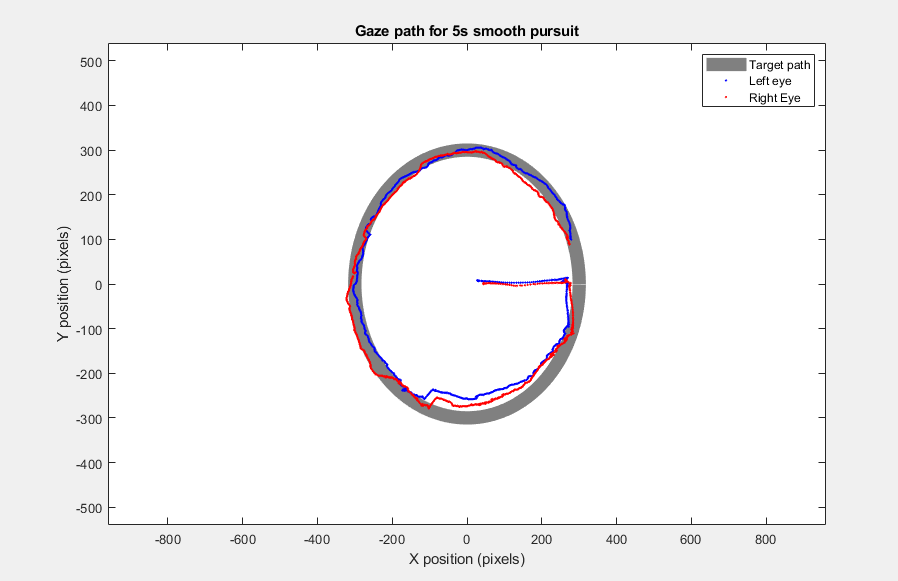This demo requires TRACKPixx Revision 18 or later. You can check for recent firmware updates at http://vpixx.com/whatsnew
This simple eye-tracking demo displays a dot moving in a circle around the center of the screen. We record 5 seconds of pursuit data. This data is then superimposed over the target path and saved into a .csv file for further analysis in your software of choice.

At the beginning of the demo there is an optional calibration step. This step calls TPxTrackpixx3CalibrationTesting, which implements a standard MATLAB TRACKPixx3 calibration script. The tracker must be calibrated for every new participant. We also recommend calibrating after a participant moves away from the chinrest.
Following calibration the demo wakes the TRACKPixx3, sets up a tracking schedule with SetupTPxSchedule, and starts this schedule with StartTpxSchedule when the target appears. This schedule controls recording of eye data, which is stored on a data buffer on the DATAPixx3 controller. We record 5 seconds of pursuit data, and plot this in MATLAB for inspection. Eye data is also written into a .csv file for further analysis.
function TPxPursuitTracking(initRequired)
%
% This demo draws a moving dot for 5 seconds, and tracks the smooth
% pursuit movement of the viewer. Data is plotted and saved.
% Most recently tested with:
% -- TRACKPixx3 firmware revision 18
% -- DATAPixx3 firmware revision 19
% -- MATLAB version 9.6.0.1150989 (R2019a)
% -- Psychtoolbox verison 3.0.15
% -- Datapixx Toolbox version 3.7.5735
% -- Windows 10 version 1903, 64bit
% Oct 22, 2019 lef Written
% Mar 26 2020 lef Updated
%% Step 1 - Initialize (if needed)
if nargin==0
initRequired=1;
end
% Get some user input
fileName= input('Enter participant name: ', 's');
fileID = [fileName '.mat'];
%If a calibration is needed, call the calibration script
if initRequired
fprintf('\nInitialization required\n\nCalibrating the device...');
TPxTrackpixx3CalibrationTesting;
end
%Connect to TRACKPixx3
Datapixx('Open');
Datapixx('SetTPxAwake');
Datapixx('RegWrRd');
%% Step 2 - Set up the TRACKPixx recording schedule
Datapixx('SetupTPxSchedule');
%write all commands to the DATAPixx device register
Datapixx('RegWrRd');
%% Step 3 - Show our image and record eye position
AssertOpenGL;
%set our recording time
viewingTime = 5;
%open window
Screen('Preference', 'SkipSyncTests', 1 );
screenID = 2; %change to switch display
[windowPtr, rect]=Screen('OpenWindow', screenID, [0,0,0]);
Screen('BlendFunction', windowPtr, 'GL_SRC_ALPHA', 'GL_ONE_MINUS_SRC_ALPHA');
Screen('Flip',windowPtr);
%determine a trajectory
radius = 300; %in pixels for now
targetSize = 20;
trajectory = 0 : 0.01 : 2*pi;
%show instructions to participant
text_to_draw = ['PURSUIT DEMO:\n\nFollow the target with your eyes.\n\nPress any key to start.'];
DrawFormattedText(windowPtr, text_to_draw, 'center', 700, 255);
Screen('Flip', windowPtr);
%wait for participant to continue
[~, ~, ~] = KbPressWait;
Screen('Flip', windowPtr);
WaitSecs(1);
% %set up recording to start on the same frame flip that shows the image.
% %We also get the time of the flip using a Marker which saves a time of the
% %frame flip on the DATAPixx clock
Datapixx('StartTPxSchedule');
Datapixx('SetMarker');
Datapixx('RegWrVideoSync');
startTime = NaN;
currentTime = NaN;
positionCounter = 0;
while ~((currentTime - startTime) >= viewingTime)
positionCounter = positionCounter + 1;
%if we get to the end of our trajectory, restart
if positionCounter > numel(trajectory)
positionCounter = 1;
end
%draw our image and flip
centerX = rect(3)/2 + radius*(cos(trajectory(positionCounter)));
centerY = rect(4)/2 + radius*(sin(trajectory(positionCounter)));
Screen('FillOval', windowPtr, [255,50,50], [centerX-targetSize/2, centerY-targetSize/2, centerX+targetSize/2, centerY+targetSize/2 ]);
Screen('Flip', windowPtr);
Datapixx('RegWrRd');
startTime = Datapixx('GetMarker');
currentTime = Datapixx('GetTime');
end
%stop recording
Datapixx('StopTPxSchedule');
Datapixx('RegWrRd');
endTime = Datapixx('GetTime');
%read in eye data
status = Datapixx('GetTPxStatus');
toRead = status.newBufferFrames;
[bufferData, ~, ~] = Datapixx('ReadTPxData', toRead);
%bufferData is formatted as follows:
%1 --- Timetag (in seconds)
%2 --- Left Eye X (in pixels)
%3 --- Left Eye Y (in pixels)
%4 --- Left Pupil Diameter (in pixels)
%5 --- Right Eye X (in pixels)
%6 --- Right Eye Y (in pixels)
%7 --- Right Pupil Diameter (in pixels)
%8 --- Digital Input Values (24 bits)
%9 --- Left Blink Detection (0=no, 1=yes)
%10 --- Right Blink Detection (0=no, 1=yes)
%11 --- Digital Output Values (24 bits)
%12 --- Left Eye Fixation Flag (0=no, 1=yes)
%13 --- Right Eye Fixation Flag (0=no, 1=yes)
%14 --- Left Eye Saccade Flag (0=no, 1=yes)
%15 --- Right Eye Saccade Flag (0=no, 1=yes)
%16 --- Message code (integer)
%17 --- Left Eye Raw X (in pixels)
%18 --- Left Eye Raw Y (in pixels)
%19 --- Right Eye Raw X (in pixels)
%20 --- Right Eye Raw Y (in pixels)
%IMPORTANT: "RIGHT" and "LEFT" refer to the right and left eyes shown
%in the console overlay. In tabletop and MEG setups, this view is
%inverted. This means "RIGHT" in our labelling convention corresponds
%to the participant's left eye. Similarly "LEFT" in our convention
%refers to left on the screen, which corresponds to the participant's
%right eye.
%If you are using an MRI setup with an inverting mirror, "RIGHT" will
%correspond to the participant's right eye.
%save eye data from trial as a table in the trial structure
eyeData = array2table(bufferData, 'VariableNames', {'TimeTag', 'LeftEyeX', 'LeftEyeY', 'LeftPupilDiameter', 'RightEyeX', 'RightEyeY', 'RightPupilDiameter',...
'DigitalIn', 'LeftBlink', 'RightBlink', 'DigitalOut', 'LeftEyeFixationFlag', 'RightEyeFixationFlag', 'LeftEyeSaccadeFlag', 'RightEyeSaccadeFlag',...
'MessageCode', 'LeftEyeRawX', 'LeftEyeRawY', 'RightEyeRawX', 'RightEyeRawY'});
%get some other trial data
pursuitTime = endTime - startTime;
%interim save
save(fileID, 'eyeData', 'pursuitTime');
%Close everything
Screen('Closeall');
Datapixx('SetTPxSleep');
Datapixx('RegWrRd');
Datapixx('Close');
%% Step 4 - Plot some gaze paths
fprintf('\nRecording lasted %f seconds', pursuitTime);
figure();
plot(radius*(cos(trajectory)), radius*(sin(trajectory)), 'Color', [0.5, 0.5, 0.5], 'LineWidth', targetSize/2);
hold on
x = eyeData.LeftEyeX(:,:);
y = eyeData.LeftEyeY(:,:);
plot(x,y, 'ob', 'linewidth', 1, 'markersize', 1);
x = eyeData.RightEyeX(:,:);
y = eyeData.RightEyeY(:,:);
plot(x,y, 'or', 'linewidth', 1, 'markersize', 1);
xlim([-rect(3)/2, rect(3)/2]);
ylim([-rect(4)/2, rect(4)/2]);
legend({'Target path','Left eye', 'Right Eye'});
xlabel('X position (pixels)');
ylabel('Y position (pixels)');
title('Gaze path for 5s smooth pursuit');
%% Step 5 - Write data to csv for subsequent analysis
savefig(fileName);
csvFileID = [fileName '_Results.csv'];
writetable(eyeData, csvFileID);
end